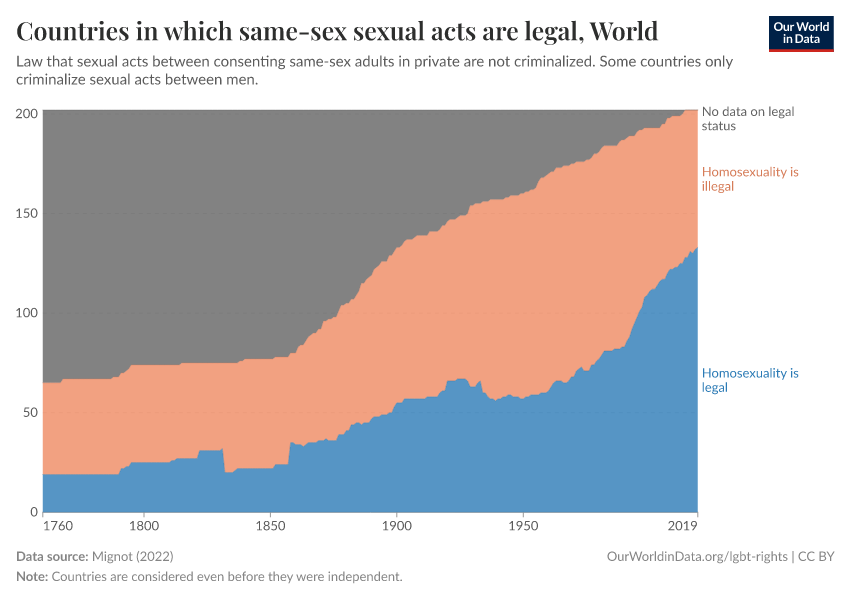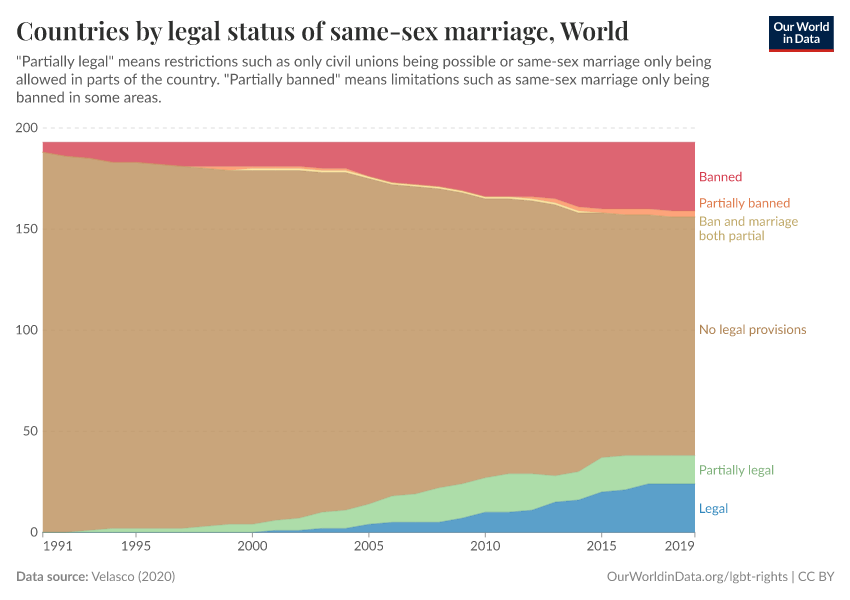LGBT+ rights have become more protected in dozens of countries, but are not recognized across most of the world
Despite progress, same-sex marriage, adoption, gender marker changes, and third genders remain unrecognized in many countries. Some have even implemented more regressive policies.
How much progress has been made in protecting the rights of LGBT+ people?
In this article, we show recent and long-term data on both the progress made and the setbacks faced.
Today, same-sex relationships are legal in most countries, several dozen countries allow same-sex marriage and joint adoption, and at least a few countries legally recognize gender marker changes and third genders.
Yet, at the same time, most countries don’t protect LGBT+ rights, and dozens have recently implemented more regressive policies, such as explicit bans on same-sex marriage.
Same-sex relationships have become legal in two-thirds of countries
One of the core rights of LGBT+ people is to love whoever they love without fear of prosecution.
Freely choosing one’s intimate partner has become more possible since the second half of the 20th century, when same-sex relationships became legally protected in many countries.
Using data from researcher Jean-François Mignot, the chart shows that in the late 18th century, same-sex intimacy was legal in only around two dozen countries, including France, Japan, and the Russian Empire.
While the Russian Empire made same-sex relationships illegal in 1832, several dozen countries, especially in Latin America, legalized them over the 19th and early 20th centuries.
After setbacks in the 1930s, legalization returned in the 1960s, particularly in Western Europe. Progress accelerated in the 1990s, starting with Eastern Europe.
By 2020, same-sex sexual acts were legal in 133 countries out of the 202 studied by Mignot.
The trends are even more positive when we look at the number of people living in countries where same-sex relationships are legal, as they have become recognized in populous countries like China and India.
You can look at the status of each country over time on our interactive map.

In dozens of countries, core LGBT+ rights have become protected
LGBT+ people don’t just want to live free from fear of being prosecuted for their same-sex relationships. Many also want to marry, adopt children with their partner, and some want their government to recognize their transgender or non-binary identity.
The chart, adding data from Equaldex, shows until the 1990s, no countries protected LGBT+ rights beyond allowing same-sex sexual acts. This has only changed in the last few decades.
Estonia was the first country to allow a gender marker change without restrictions in 1992, and a few dozen countries have done the same in subsequent years.1
The Netherlands was the first country to allow joint adoptions in 2000, and more than thirty countries have followed since then.
The same goes for same-sex marriage, where the Netherlands was again the first country to legalize it in 2001.
Finally, in 2012, New Zealand became the first country to recognize a non-binary gender on its passports. Since then, several other countries have legally recognized third genders.
Again, when we look at the number of people living in countries that protect these core rights, the trends for same-sex marriage, adoption, and gender marker changes are similar. The trend for third-gender recognition looks even better, thanks to India and Pakistan recently recognizing a third gender.

In most countries, LGBT+ rights remain largely unprotected
The next charts show in more detail which countries grant core LGBT+ rights, using data from Equaldex.
The first chart shows that same-sex relationships are legal in many countries.2 But this is not true everywhere. In some countries, same-sex relationships between men are illegal, and in others, they have to fear being punished with prison or even death.3
Even in places where same-sex relationships are legal, the age of consent may still be higher than for different-sex partners.

The next chart shows the few dozen countries allowing same-sex partners to marry, affirming their right to love and form a family. Most of them also allow same-sex couples to adopt together, giving more children a stable and loving home.
More countries legally recognize these partnerships through civil unions or allow couples to live together.
Most countries, though, don’t recognize same-sex marriage or outright ban it. In them, same-sex couples cannot have the state formally acknowledge their partnership, are unable to claim marital benefits such as pensions, and cannot share custody of their children.

The third chart identifies the countries that allow people to change their gender on official documents without restrictions, thereby validating people’s gender identity and reducing misgendering, discrimination, and harassment.
In dozens of other countries, people must first have a medical diagnosis or undergo surgery.
Yet, in many countries, changing one’s gender in official documents is illegal. Therefore, many people have to live with the painful tension between the gender stated in their papers and their actual gender identity and cannot get any support from the state to receive care that affirms their gender.

The last chart shows that more than a dozen countries recognize a gender other than “man” or “woman” in official documents, providing validation and protection from discrimination. A few additional countries at least legally recognize intersex people.
But in most, third genders aren’t legally recognized at all. Even where they are, in some cases, that may be a cause for exclusion.

When we combine the data on these policies and others — policies like discrimination in housing and employment, censorship, surgery on intersex infants, and gender-affirming care — into an overall index of legal equality, we similarly see the highly uneven protection of LGBT+ rights across the world.
Dozens of countries have implemented more regressive, hostile policies
While some countries have granted more rights to LGBT+ people, others are moving in the opposite direction.
Using data from researcher Kristopher Velasco, the chart shows one example: the significant increase in the number of countries that explicitly ban same-sex marriage.4
In 1991, five countries had an explicit ban on same-sex marriage. By 2019, the latest year with available data, 37 countries had such bans, which were concentrated in Eastern Europe and Sub-Saharan Africa.5
While the previous lack of legal provisions often meant that same-sex marriage was impossible in these places, there was at least the potential that existing laws would be interpreted and enforced differently.
The specific countries that ban same-sex marriage are shown in our related chart.
In this way, LGBT+ rights are becoming more polarized: fewer countries have no explicit laws on the issue, while some are becoming more progressive and others more regressive.
Two more examples of recent regressive policies are laws that ban “propaganda for non-traditional sexual relations”, which discriminate against LGBT+ people in the name of protecting “public morality,” and a few countries imposing the death penalty on same-sex relationships after previously not doing so.

The world is still far from equal on these issues
Parts of the world have become much more welcoming to LGBT+ people. Just a few decades ago, most couldn’t legally be in a same-sex relationship, and none could marry a partner of the same sex, adopt a child with them, or have their gender legally recognized.
But there is still a long way to go. Very few countries have established comprehensive legal rights supporting LGBT+ people. And changing laws is not enough; it also requires changes in people’s attitudes. We must reduce discrimination against LGBT+ people in their daily lives, including addressing the disproportionate violence against them and ensuring their equal access to healthcare.
The historical and recent trends show that progress on LGBT+ rights is possible. But much more work is needed to build societies where LGBT+ people can equally thrive.
We thank Edouard Mathieu and Hannah Ritchie for their helpful comments and suggestions on this text.
Keep Reading on Our World in Data
Endnotes
Estonia later restricted gender marker changes by requiring a medical diagnosis.
The exact countries between Equaldex and Mignot differ because laws in some countries are ambiguous, and they come to different conclusions.
For example, Iran executed two men in 2022, and Yemen sentenced nine to death in 2024.
The numbers between Velasco and Equaldex differ because laws in some countries are ambiguous, and they come to different conclusions.
The trend is similar when we look at the number of people living in countries with same-sex marriage bans.
Cite this work
Our articles and data visualizations rely on work from many different people and organizations. When citing this article, please also cite the underlying data sources. This article can be cited as:
Bastian Herre and Pablo Arriagada (2024) - “LGBT+ rights have become more protected in dozens of countries, but are not recognized across most of the world” Published online at OurWorldinData.org. Retrieved from: 'https://archive.ourworldindata.org/20251125-173858/progress-lgbt-rights.html' [Online Resource] (archived on November 25, 2025).BibTeX citation
@article{owid-progress-lgbt-rights,
author = {Bastian Herre and Pablo Arriagada},
title = {LGBT+ rights have become more protected in dozens of countries, but are not recognized across most of the world},
journal = {Our World in Data},
year = {2024},
note = {https://archive.ourworldindata.org/20251125-173858/progress-lgbt-rights.html}
}Reuse this work freely
All visualizations, data, and code produced by Our World in Data are completely open access under the Creative Commons BY license. You have the permission to use, distribute, and reproduce these in any medium, provided the source and authors are credited.
The data produced by third parties and made available by Our World in Data is subject to the license terms from the original third-party authors. We will always indicate the original source of the data in our documentation, so you should always check the license of any such third-party data before use and redistribution.
All of our charts can be embedded in any site.